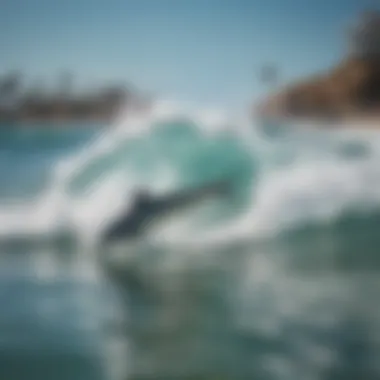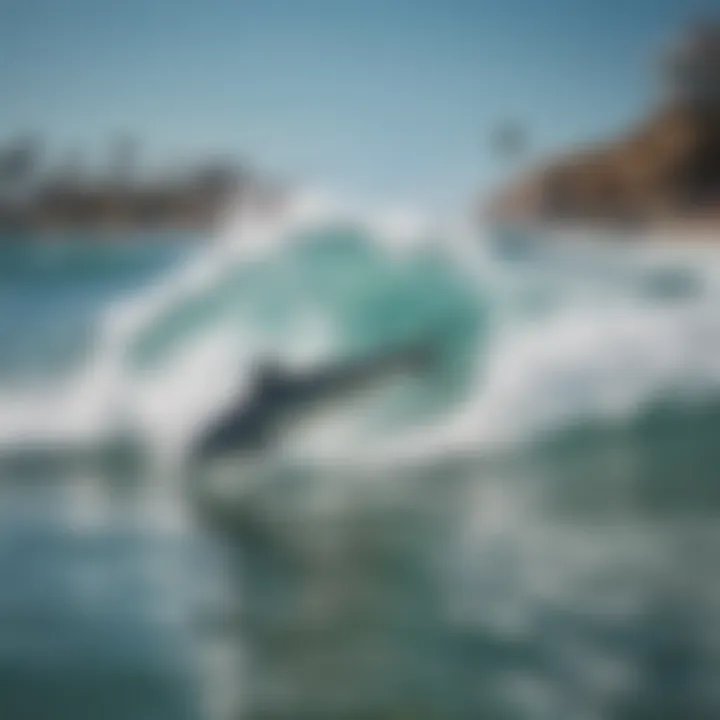Exploring the Role of Jacks in Huntington Beach


Intro
Huntington Beach is not just another coastal spot with sun and surf; it’s a unique ecosystem where various marine species, including jacks, find their home. Jacks, particularly known for their swift movements and vibrant presence, hold a special place in the hearts of locals. They are more than just fish; they are part of the fabric of surf culture, an intricate bond between the ocean and surfers who ride the waves.
The significance of understanding the relationship between jacks and the coastal environment stretches beyond casual observation. It encompasses ecological health, the sustainability of marine practices, and an essential connection to the community. This article aims to shed light on various aspects of jacks in Huntington Beach—from their behavior and habitat to their importance in local surfing culture and conservation efforts.
An in-depth examination not only benefits surfboarding enthusiasts but also highlights the necessity of marine preservation, particularly as we navigate the challenges of overfishing and environmental changes. It invites everyone to embrace the profound interdependency between the ocean's bounty and those who seek pleasure from its waters.
Through this exploration, we will dive into techniques that surfers can use while engaging with the ocean, examine equipment that enhances the experience, and discuss how jacks directly influence both surf culture and sustainability practices.
Prolusion to Jacks in Huntington Beach
Understanding the role of jacks in Huntington Beach is crucial for both marine enthusiasts and casual beachgoers alike. These vibrant fish are not just a spectacle; they are an essential part of the coastal ecosystem and the local culture. Every year, they draw surfers, anglers, and eco-enthusiasts to the shores, contributing to a dynamic interaction between nature and human activity.
Often, folks think of jacks merely as fish to catch or watch, but they embody a deeper narrative about marine health and sustainability. Their presence signals rich waters teeming with life. Jacks play a pivotal role in the food web, influencing the abundance and behavior of other species. Without a good understanding of these fascinating creatures, we risk losing touch with the delicate balance of our coastal ecosystems and the unique cultures that have sprung up around them.
Overview of Jacks
Jacks are a family of fish known for their speed and strength, making them favorites among sportfishers. They are characterized by their streamlined bodies and powerful tails, which allow them to dart through the water with incredible agility. When fishing for jacks, one can expect an exhilarating struggle, as these fish are not easily caught. Among the most notable species found in this region is the California yellowtail, famed for its size and delicious meat. Other related species can also be spotted, making the waters off Huntington Beach a hotspot for anglers seeking the thrill of the catch.
In terms of behavior, jacks often hunt in schools, a fascinating sight for both surfers and spectators. They tend to be more active during certain times of the day, particularly when pursuing smaller fish or during spawning season. Observing a school of jacks can give insights into their feeding habits and social interactions, enriching the experience of anyone spending time by the ocean.
Huntington Beach's Coastal Ecosystem
The coastal ecosystem of Huntington Beach is a complex web of interactions among various species, including jacks. This ecosystem thrives on the balance between predators and prey, with jacks serving as both hunters and a food source for larger marine animals. The waters here are nutrient-rich, influenced by both natural currents and human activity.
The kelp forests and underwater structures near the beach harbor numerous species that coexist with jacks. These environments provide shelter, breeding grounds, and abundant food, demonstrating a fragile but crucial relationship that depends on cleanliness and healthy marine practices. Local surfers often witness the interplay between various marine life firsthand, reinforcing the need for conservation.
In essence, recognizing the ecological importance of jacks in Huntington Beach is not just for scientific inquiry but also for the broader implications it may have on the community and local culture. By understanding their role and advocating for sustainable practices, we can maintain the vibrant ecosystem that makes Huntington Beach a beloved destination for many.
Species of Jacks Found in the Area
The coastal waters of Huntington Beach are home to a vibrant array of marine life, and the presence of jacks adds a unique dimension to the ecosystem. These species are not just numerically significant; they are also vital to the local fishing culture and the health of the ocean. Understanding the different species of jacks found here can radically shift perspectives on conservation and fishing practices.
The California Yellowtail
Among the various jack species, the California Yellowtail stands out. This fish, known scientifically as Seriola lalandi, is highly prized for its delicious flavor and sporting qualities, making it a favorite among local anglers. Weighing up to 100 pounds and stretching over three feet long, spotting this fish is often seen as a rite of passage for many surfers and fishers alike.
The California Yellowtail typically inhabits the offshore waters, often found around rocky reefs and kelp beds. Seen as opportunistic feeders, they primarily dine on smaller fishes and squid, showcasing their predatory nature. Their striking coloration—dark blue-green on the top with a shining silver side and yellow stripe—makes them a spectacular sight both in and out of the water.
In terms of cultural relevance, the California Yellowtail is more than just a fish; it's a central character in local fishing tournaments and culinary spots. Many restaurants feature this species on their menus, highlighting the importance of sustainable sourcing, so it’s not just about catching but also about eating mindfully.
Other Notable Jack Species
While the California Yellowtail may steal the spotlight, other jack species are also important within Huntington Beach waters.


- Pacific Jack Mackerel (Decapterus spp.) – Recognizable by their slender bodies and sharp, tapered fins, these jacks tend to school in large numbers, providing a significant catch for both commercial and recreational fishing.
- Horse Mackerel (Trachurus trachurus) – Not to be confused with its namesake tuna, this fish stands out for its ability to thrive in various environments, making it lesser-known but no less crucial to the ecosystem.
- Amberjack (Seriola dumerili) – Another predator, this species is noted for its speed and strength, appealing to sport fishers seeking a challenge on the line.
To fully appreciate the role of these species, it’s essential to acknowledge their behavior and interactions within the marine ecosystem. Each species has its unique niche that contributes to the dynamic balance of life in the sea.
"The sheer variety of jack species in Huntington Beach amplifies the area’s ecological richness and underscores the importance of preserving these vital marine environments."
Behavior and Habitat of Jacks
The behavior and habitat of jacks play a pivotal role in understanding their ecological impact in Huntington Beach. Jacks are not just another species in the ocean; they are dynamic creatures that contribute significantly to the coastal ecosystem and influence local fishing and recreational activities. Knowing how jacks behave and where they thrive can offer insights not only into their survival but also into the health of the marine environment they inhabit.
Feeding Patterns
Jacks are predatory fish, and their feeding habits are both intricate and fascinating. They often hunt in groups, demonstrating a unique level of social behavior. This cooperative hunting strategy allows them to efficiently catch larger prey. Additionally, they are known to consume a diverse diet that includes smaller fish, squid, and crustaceans.
"Jacks are like the wolves of the sea, known for their teamwork when pursuing prey."
Their feeding patterns shift depending on seasonal availability of food and environmental conditions. For instance, during warmer months, when baitfish tend to proliferate near the surface, jacks can be seen aggressively hunting them down. Surfers and anglers might notice a flurry of activity as the jacks push schools of bait toward the shore, creating a thrilling spectacle. This not only enriches the feeding dynamics but also attracts larger predators, contributing to a lively atmosphere around surf zones.
Some specifics about their feeding include:
- Time of Day: Jacks often feed at dawn and dusk when their prey is more active.
- Hunting Techniques: They use speed and agility to outpace their prey, typically launching into bursts of high-energy swimming.
- Influence of Tides: The tidal cycles can impact their hunting successes, with feeding often peaking during incoming tides when eddies form, bringing food closer to the shore.
Reproductive Habits
When it comes to the reproductive habits of jacks, they follow an annual spawning cycle that reflects both environmental cues and the health of their habitat. Most jacks exhibit a fascinating strategy known as batch spawning, where females release multiple batches of eggs throughout the spawning season. This method enhances the survival odds of their offspring by ensuring that not all eggs are laid at once, minimizing predation risks.
During this period, jacks tend to migrate to specific breeding grounds that offer suitable conditions for their eggs. These areas often have a mix of sandy and rocky substrates, providing protection for the newly hatched fish.
Key points about their reproductive habits include:
- Spawning Locations: Jacks favor offshore reefs and rocky outcrops, which provide shelter for eggs and larvae.
- Fertilization: Unlike some other fish species, fertilization occurs externally, with males racing to fertilize the floating eggs soon after they are released.
- Life Cycle Stages: After hatching, juvenile jacks typically seek shelter in coastal lagoons and marshes, where they benefit from abundant food sources and protection from larger predators.
Understanding these behaviors can shockingly highlight the interconnectedness of local marine life. The health of jack populations often reflects broader ecological conditions, and thus their reproductive trends can serve as vital indicators of marine ecosystem health.
In summary, the behavior of jacks, particularly their feeding strategies and reproductive habits, underscores their critical role in the marine food web. This knowledge enriches not only ecological studies but also enhances the quality of the surfing experiences and fishing practices in Huntington Beach, reminding surfers and eco-enthusiasts alike of their shared responsibility to preserve these vital waters.
Impact of Jacks on the Local Surf Culture
The relationship between jacks and the surfing culture in Huntington Beach is one that extends beyond mere coexistence. These fish are more than just part of the marine life; they’re intricately woven into the very fabric of the surf experience. Understanding this impact helps highlight the symbiotic connection between surfers and the ecosystem they inhabit.
The Surfing Experience Amidst the Jacks
Surfing at Huntington Beach can often feel like a dance with the ocean, and the presence of jacks adds a unique rhythm to this interaction. When paddling out, surfers might find themselves sharing the water with schools of California Yellowtail or other jack species. This interaction isn’t just thrilling; it's a reminder of the vibrant life beneath the waves.
Surfers often speak about the excitement when they catch a glimpse of these fish darting beneath them. The jacks, known for their acrobatics and speed, create a lively spectacle that enhances the overall surf experience. Many a surfer has stopped mid-ride to appreciate the agile movements of a yellowtail breaking the surface, a moment that can only be described as magical.
Moreover, jacks can impact surf conditions. Their feeding habits may attract larger predators, which, in turn, can influence where surfers choose to ride. Sometimes, this creates elusive spots known for better swells when jacks are present. But it’s not merely about the thrill; it represents a larger connection between aquatic life and surfing culture.


"Surfers have a unique relationship with marine life, and jacks are often seen as their companions in the waves."
Community Events Celebrating Jacks
Events celebrating jacks in Huntington Beach are not just gatherings; they serve as platforms for surfers and locals to deepen their connection to the marine environment. For instance, the annual Jack Fest attracts surf enthusiasts, families, and conservationists alike. This event celebrates the beauty of jacks, featuring educational workshops, surf competitions, and even fishing clinics that promote sustainable practices.
Such gatherings foster community spirit and raise awareness of the vital role jacks play in the local ecology. They underline the importance of maintaining healthy fish populations for both ecological balance and the surfing experience. By engaging local schools and organizations, these events help educate the younger generation about marine conservation.
Additionally, through surfing competitions, artists, and vendors, the festivities inspire creativity and unity. Participants often share memorable stories about their encounters with jacks, enriching the local culture with personal experiences. The enthusiasm exhibited during these events often energizes efforts to advocate for conservation, encouraging surfers to become stewards of the ocean.
Regulations and Management of Jack Populations
The sustainable management of jack populations in Huntington Beach is not just a wise course of action—it's a necessity for the health of the coastal ecosystem and the local community that thrives around it. As these fish play a significant role in marine life, ensuring their populations are robust helps maintain the balance of the underwater world. Several regulations and initiatives are in place to safeguard these important species, and understanding them is essential for anyone invested in the area, from surfers to commercial fishers.
Balancing fishing activities with conservation efforts presents unique challenges. Effective regulations are crucial to prevent overfishing and encourage practices that respect the marine environment. With guidelines that shift over time due to environmental changes and fish populations, it’s important for stakeholders to stay updated. Regulations can help create a long-term strategy for maintaining fish stocks, fostering a healthy ecosystem that benefits all.
"Sustainability isn’t just a buzzword; it’s a lifeline for communities reliant on marine resources."
Current Fishing Regulations
In Huntington Beach, fishing regulations are designed to strike a balance between recreational and commercial fishing while ensuring the long-term viability of jack species. Key points of these regulations include:
- Size and Bag Limits: There are specific minimum size requirements for jacks to be kept. This helps to ensure that younger fish have a chance to grow and reproduce before being caught. The bag limit restricts the number of fish an angler can take in one day, which further helps in controlling the population.
- Seasonal Restrictions: Certain times of the year may be designated for catch-and-release only. This allows for breeding periods when fish stocks naturally need to replenish.
- Permits: Recreational and commercial fishers must obtain the appropriate licenses, which often come with varying regulations depending on the type of fishing (shoreline vs. boat).
These rules are critical, ensuring that everyone—whether you're chasing the thrill of a catch or simply enjoying the sun—can appreciate the bounty that the ocean provides.
Conservation Efforts in Place
The local community is actively involved in conserving jack populations through various initiatives that work hand in hand with stated regulations. Efforts include:
- Community Awareness Campaigns: Local organizations often conduct workshops and seminars to educate anglers about the importance of sustainable fishing practices. Educating about the ecological significance of jacks helps foster respect for their role in the marine environment.
- Beach Clean-ups: Engaging community members in beach clean-up efforts not only helps preserve the ocean but also enhances local habitats for jacks and other marine species. A clean ocean is a healthy ocean, and this rings especially true for sensitive coastal ecosystems.
- Monitoring Programs: Regular assessments on jack populations gather data to inform future regulations. Local researchers and volunteers often collaborate on these initiatives to ensure that there is a solid understanding of current population dynamics.
- Restoration Projects: Efforts to restore habitats affected by human activities contribute to the overall health of jack populations. By addressing environmental degradation, like the loss of kelp forests, efforts can enhance the habitat where jacks thrive.
By intertwining conservation efforts with regulations, communities can create a robust framework that allows both fish populations and surfers alike to thrive. The ongoing dialogues between environmental groups, government bodies, and fishers ensure that the delicate balance of the ecosystem is not only respected but actively preserved.
Sustainable Fishing Practices for Jacks
Sustainable fishing practices are crucial, especially in regions like Huntington Beach, where the ecological balance can easily be tipped by overfishing or irresponsible angling. The importance of sustainable fishing cannot be overstated, as it goes beyond mere regulations. It encompasses a commitment to protecting marine ecosystems while allowing local communities to thrive economically. This section aims to shed light on effective methods that both seasoned anglers and newcomers can adopt to minimize their impact on Jack populations.
Best Practices for Anglers
For anglers hoping to reel in a Jack, several practices can ensure that their passion supports environmental sustainability:
- Catch and Release: This method is not only encouraged but often essential for Jack species. If you’re fishing for fun rather than food, ensure that you handle the fish gently and return them to the water promptly. Keeping them out for extended periods can cause stress or injury.
- Use the Right Gear: Invest in tackle that minimizes harm to fish. For instance, barbless hooks can reduce injury rates when fish are released. Opting for lighter gear can also facilitate easier handling.
- Educate Yourself: Stay informed about the specific Jack species in the area. Knowing their habits and habitats can dramatically increase your chances of fishing responsibly. For instance, understanding seasonal migrations helps avoid fishing during spawning periods, crucial for population regeneration.
- Follow Local Guidelines: Each area has its regulations for fishing limits and seasons. Compliance not only protects fish but also supports the local economy and conservation efforts. Ignorance of these laws can harm the very fisheries that your community relies on.
- Support Local Initiatives: Engaging with local conservation groups can amplify the message of sustainability. They might organize workshops or clean-up events, allowing you to contribute to the fight against pollution affecting Jack populations.
Community Involvement in Sustainability
A vibrant community can play a significant role in promoting sustainable practices. In Huntington Beach, various stakeholders are joining forces to ensure that future generations enjoy fishing and surfing together. Here’s how:


- Collaborative Efforts: Local fishing clubs, surf organizations, and conservation groups often collaborate on initiatives aimed at protecting marine life. For example, beach clean-up days not only tackle litter but also raise awareness about the impact of debris on Jack habitats.
- Youth Education Programs: Engaging the younger generation is vital. Programs in schools that include educational trips to local waters or presentations about marine ecosystems can foster appreciation and respect for ocean life.
- Social Media Campaigns: Platforms like Facebook and Reddit provide a stage for sharing success stories, sustainable practices, and joint community efforts to help spread the goal of sustainability. A tag about a successful catch-and-release event can inspire others in the community.
Remember: "What we do today, echoes in eternity." The choices we make in our fishing practices affect the ocean's future.
- Feedback from the Community: Creating spaces for discussion about fishing practices can lead to actionable solutions. Regular town hall meetings provide a venue for community members to share ideas and voice concerns.
- Sponsorship of Local Regulations: Anglers and surfers actively involved in their communities can lobby for better fishing regulations. Attending local government meetings while advocating for sustainable practices can have lasting impacts on Jack conservation.
By employing best practices and engaging in community efforts, the fishing community in Huntington Beach can ensure that the rich legacy of Jacks continues for future anglers and surfers alike.
The Future of Jacks in Huntington Beach
The future of jacks off the coast of Huntington Beach stands at a crossroads, dictated by both human activity and natural forces. Understanding this pivotal topic isn’t just intellectual exercise; it’s crucial for the surfing community and conservation efforts as well. With the rising tide of climate change and its associated effects on marine ecosystems, the well-being of jack populations becomes a reflection of the health of our coastal waters.
Climate Change and Its Effects
Climate change is not just a distant theory anymore—it’s happening right outside our doors, and it has direct implications for marine life, especially for species like jacks. As water temperatures increase, the habitats that jacks depend on become altered, potentially impacting their migration patterns and breeding cycles. These fish are sensitive to changes in their environment. Warmer waters may push them to deeper or cooler areas, which might affect the fishing experiences for local anglers and surfers alike.
Moreover, ocean acidification, a consequence of excess carbon dioxide in the atmosphere, poses serious threats to the food web. Jacks, being higher up in that food chain, could find their future living spaces compromised if their prey—like small fish and crustaceans—are impacted by these changes.
A few specific impacts to consider include:
- Shift in Distribution: Jacks may migrate north or deeper as their optimal conditions change. This movement could challenge longstanding fishing grounds.
- Altered Feeding Patterns: Changes in prey availability may lead to competition within species, stressing jack populations.
- Breeding Challenges: Warmer waters influence reproductive timing, potentially leading to mismatches in spawning cycles and food availability.
Predictions for Jack Populations
Looking ahead, predictions for jack populations in Huntington Beach hinge on a mix of optimism and caution. While jacks are resilient creatures, their longevity depends on how well both the natural ecosystem and human interventions can adapt.
Key points to monitor include:
- Population Recovery: If effective conservation measures are put in place and adhered to, certain jack species might see population increases.
- Impact of Regulations: Stricter fishing regulations and sustainable practices can support population stability. Keeping an eye on fishery management practices could yield positive results.
- Ecosystem Health: Overall, the health of the coastal ecosystem is tied to the survival of jack populations. Efforts toward habitat restoration will play a significant role in their future.
In sum, while the future may look uncertain, there is a silver lining. With concerted effort from surfers, local communities, and conservationists, the plight of jacks can transform into a success story that not only benefits the fish but the entire coastal ecosystem and the surf culture that thrives around it.
"Protecting our coastline today means preserving our surf culture and marine life for tomorrow."
Epilogue
The exploration of jacks in Huntington Beach brings forth an understanding that transcends mere observation of their presence. Understanding the role of these fish in the coastal ecosystem reveals a broader narrative of environmental interconnectivity that is vital not only for jacks themselves but also for surfers, local communities, and future generations. The intricate relationship between jacks and their habitat illustrates the delicate balance required to maintain ecological health amidst various pressures such as climate change and human activities.
Summary of Key Insights
In summarizing the core points discussed throughout the article, several key insights emerge:
- Jacks, particularly species like the California Yellowtail, play a crucial role in maintaining the health of marine ecosystems in Huntington Beach.
- Their behavioral patterns, such as feeding and reproduction, directly impact the local surf culture and recreational activities.
- Engagement from the community, including surfers and conservationists, is essential in promoting sustainable practices that protect these species.
- Regulatory efforts and management strategies are in place, yet their effectiveness relies on continued advocacy and awareness among the public.
Each of these insights reinforces the notion that jacks are not just fish swimming in the Pacific; they are vital components of a rich tapestry that supports biodiversity and nurtures community spirit. By understanding their significance, we acknowledge our role in conserving this unique marine environment.
Call to Action for Conservation
The call to action is clear. Awareness alone is insufficient; proactive measures must be taken to ensure the sustainability of jack populations in Huntington Beach. Here are some steps that surfers, local residents, and community members can consider:
- Participate in local conservation initiatives, supporting organizations that aim to protect marine life.
- Engage in sustainable fishing practices and encourage others to do the same, minimizing the impact on jack populations.
- Stay informed about regulations surrounding fishing and wildlife management, advocating for policies that prioritize ecological health.
- Share knowledge and experiences through social media platforms, fostering a communal awareness of conservation efforts through channels such as Reddit and Facebook.
"The true measure of any society can be found in how it treats its most vulnerable members." – Mahatma Gandhi















